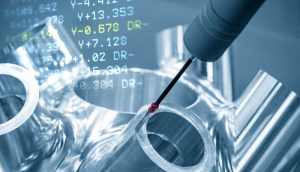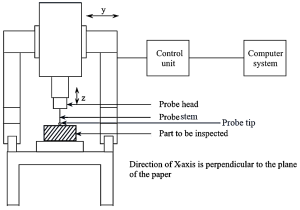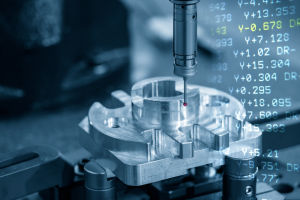3D Measurement and CMM: Principles, Functionality, and Industrial Applications
Three-dimensional (3D) measurement systems are critical tools in modern manufacturing processes, especially when precision and quality control are paramount. These systems enable the capture of accurate geometric data about physical objects, facilitating precise analysis, inspection, and verification of parts or products. One of the most widely used technologies for 3D measurement is the Coordinate Measuring Machine (CMM), a versatile and highly precise instrument that plays a vital role in ensuring the dimensional accuracy of manufactured components. This paper explores the principles behind 3D measurement, the working mechanism of CMMs, and their industrial applications.

Principles of 3D Measurement and CMM Technology
3D measurement systems rely on the capture of spatial data across three axes: X, Y, and Z. These systems use a variety of technologies, including mechanical, optical, and laser-based sensors, to measure the position of points on an object’s surface. The data is then processed to create a virtual model or map of the object, which is compared to design specifications for quality control.

1. Coordinate Measuring Machines (CMM) Overview
CMMs are machines designed to measure the physical geometrical characteristics of an object. They are equipped with one or more probes, such as mechanical, optical, or laser sensors, that touch or scan the object’s surface. The movement of the probe along three axes is controlled by a computer, which allows for the precise measurement of the object’s dimensions, angles, and surface features.
CMMs come in several types, including:
- Bridge CMM: Typically used for medium to large parts, where the probe moves along the X, Y, and Z axes in a fixed, structured manner.
- Cantilever CMM: Known for its simplicity and flexibility, suitable for measuring smaller parts.
- Gantry CMM: Large-scale CMMs used for measuring large or heavy components.
- Portable CMM: Highly flexible machines that can be used on-site for measuring large or awkwardly shaped parts.
The CMM’s ability to provide highly accurate measurements makes it indispensable in industries requiring stringent quality control, such as aerospace, automotive, and electronics.
How CMMs Work
CMMs operate by systematically probing an object’s surface and recording the position of these contact points. The machine is calibrated to measure distances, angles, and other geometrical attributes with high precision.
1. Probing Methods
CMMs use various probing techniques to gather data from an object’s surface:
- Contact Probing: The probe physically touches the object at predefined points. As the probe contacts the surface, it generates a signal that the CMM uses to record the point’s position.
- Non-contact Probing: Technologies such as laser scanning, optical, and white light probes allow for non-contact measurement, ideal for sensitive or soft materials where physical contact could damage the object.
These probes collect millions of points that represent the object’s geometry. The system then processes this data to generate a 3D model of the part, which is compared to the original CAD (Computer-Aided Design) model.

2. Data Processing and Analysis
Once the measurement data is captured, the CMM’s software analyzes it in relation to the part’s design specifications. This involves comparing the recorded measurements with the theoretical dimensions defined in CAD models or engineering drawings. Deviations from the design are flagged, and tolerances are checked to ensure the part meets the required standards.
Advanced CMM systems can also perform statistical analyses, such as measuring form, surface finish, and alignment, to identify potential defects in manufacturing. The ability to automatically compare physical measurements with digital designs enhances the efficiency and accuracy of quality control processes.
Industrial Applications of 3D Measurement and CMM
CMMs play a crucial role in several industries where precision is critical. These machines are integral to the production of high-quality parts, particularly in industries like aerospace, automotive, medical device manufacturing, and electronics.
1. Quality Control and Inspection
CMMs are predominantly used in quality control to ensure that manufactured parts conform to strict tolerances and design specifications. By measuring components at various stages of production, manufacturers can detect deviations from the design early, preventing defects from advancing further down the production line. This results in higher product quality and fewer rejections.
In high-precision industries, such as aerospace, the accuracy provided by CMMs ensures that components function as intended in complex assemblies. For instance, turbine blades and engine parts must adhere to extremely tight tolerances to ensure safety and performance.
2. Reverse Engineering
In reverse engineering, CMMs are used to measure physical objects and generate digital models from the collected data. This process is useful for replicating or improving existing parts when no original CAD files are available. Industries such as automotive or consumer electronics frequently rely on reverse engineering to refurbish or upgrade older products.
3. Prototyping and Product Development
In product development, CMMs are used to validate prototypes and ensure that new designs are manufacturable within specified tolerances. These machines help verify that the first iteration of a product prototype adheres to the intended specifications before it goes into mass production. By comparing the prototype against the CAD model, engineers can identify potential design flaws early, reducing costly iterations.
Future Developments and Challenges
As industrial demands for precision increase, the capabilities of CMMs and 3D measurement systems continue to evolve. The integration of advanced sensors, artificial intelligence (AI), and machine learning into CMM systems is likely to improve their functionality, allowing for more complex and faster measurements. Additionally, the growing trend of Industry 4.0 and smart factories will likely lead to more interconnected and automated measurement systems that integrate seamlessly with other production processes.
However, the adoption of these advanced systems also presents challenges, such as the high initial investment costs, the need for specialized training for operators, and the complexity of handling massive amounts of measurement data in real-time.
Conclusion
3D measurement systems, particularly CMMs, have revolutionized manufacturing by enabling precise, accurate, and efficient inspection of complex components. These systems ensure that parts meet rigorous quality standards, improve production efficiency, and reduce costs associated with defects. The ability to automate and streamline measurement and analysis processes has made CMMs indispensable in industries that demand the highest levels of precision. As technology advances, the role of 3D measurement and CMMs will continue to grow, offering even more capabilities for enhanced production and quality control.








